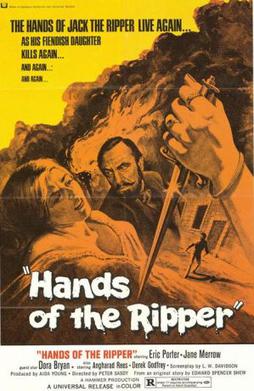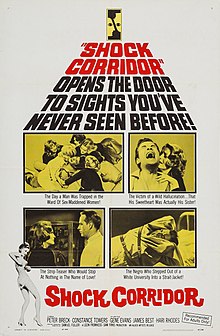
The Snake Pit is a 1948 American psychological drama film directed by Anatole Litvak and starring Olivia de Havilland, Mark Stevens, Leo Genn, Celeste Holm, Beulah Bondi, and Lee Patrick. Based on Mary Jane Ward's 1946 semi-autobiographical novel of the same name, the film recounts the tale of a woman who finds herself in an insane asylum and cannot remember how she got there.

The Big Red One is a 1980 American epic war film written and directed by Samuel Fuller, and starring Lee Marvin alongside an ensemble supporting cast, including Mark Hamill, Robert Carradine, Siegfried Rauch, Bobby Di Cicco, and Kelly Ward.
Stanley Cortez, A.S.C. was an American cinematographer. The younger brother of actor and director Ricardo Cortez, Stanley worked on over 70 films, including Orson Welles' The Magnificent Ambersons (1942), Charles Laughton's The Night of the Hunter (1955), Nunnally Johnson's The Three Faces of Eve (1957), and Samuel Fuller's Shock Corridor (1963) and The Naked Kiss (1964).

Samuel Michael "Sam" Fuller was an American film director, screenwriter, novelist, journalist, actor, and World War II veteran known for directing low-budget genre movies with controversial themes, often made outside the conventional studio system. Fuller wrote his first screenplay for Hats Off in 1936, and made his directorial debut with the Western I Shot Jesse James (1949). He would continue to direct several other Westerns and war thrillers throughout the 1950s.

Boogeyman is a 2005 supernatural horror film directed by Stephen Kay and starring Barry Watson, Emily Deschanel, Skye McCole Bartusiak, Tory Mussett, Charles Mesure, and Lucy Lawless. Written by Eric Kripke, Juliet Snowden, and Stiles White, from a story by Kripke, the film is a new take on the classic "boogeyman", or monster in the closet, who is the eponymous antagonist of the film. The plot concerns a young man, Tim Jensen, who must confront the childhood terror that has affected his life.

The Jacket is a 2005 American science-fiction psychological thriller film directed by John Maybury and starring Adrien Brody, Keira Knightley, Kris Kristofferson and Jennifer Jason Leigh. It is partly based on the 1915 Jack London novel The Star Rover, published in the United Kingdom as The Jacket. Massy Tadjedin wrote the screenplay based on a story by Tom Bleecker and Marc Rocco. The original music score is composed by Brian Eno and the cinematography is by Peter Deming.

The Naked Kiss is a 1964 American neo-noir melodrama film written and directed by Samuel Fuller and starring Constance Towers, Anthony Eisley, Michael Dante and Virginia Grey. It was Fuller's second film for Allied Artists after his 1963 film Shock Corridor.

Maniac is a 1934 American black-and-white exploitation horror film directed by Dwain Esper and written by Hildagarde Stadie, Esper's wife, as a loose adaptation of the 1843 Edgar Allan Poe story "The Black Cat", with references to his "Murders in the Rue Morgue". Esper and Stadie also made the 1936 exploitation film Marihuana.

The Believers is a 1987 Canadian-American neo-noir thriller horror-noir film directed by John Schlesinger, starring Martin Sheen, Robert Loggia and Helen Shaver. It is based on the 1982 novel The Religion by Nicholas Conde.

Revenge of the Ninja is a 1983 American martial arts–thriller film directed by Sam Firstenberg, and starring martial artist Sho Kosugi, Keith Vitali, Virgil Frye and Kane Kosugi. The plot follows a ninja trying to protect his only son from a cabal of ruthless gangsters.

Anguish is a 1987 Spanish-produced horror film directed by Bigas Luna and starring Zelda Rubinstein, Michael Lerner, Talia Paul, Angel Jove and Clara Pastor.

From Hell is a 2001 period detective horror film directed by the Hughes Brothers and written by Terry Hayes and Rafael Yglesias. It is loosely based on the graphic novel of the same name by Alan Moore and Eddie Campbell about the Jack the Ripper murders. The film stars Johnny Depp as Frederick Abberline, the lead investigator of the murders, and Heather Graham as Mary Kelly, a prostitute targeted by the Ripper. Other cast members include Ian Holm, Robbie Coltrane, Ian Richardson and Jason Flemyng.

Hands of the Ripper is a 1971 British horror film directed by Peter Sasdy and starring Eric Porter, Angharad Rees and Jane Merrow. It was produced by Aida Young for Hammer Film Productions, and written by L. W. Davidson from a story by Edward Spencer Shew. The film was released in the U.S. as a double feature with Twins of Evil (1971).

Constance Mary Towers is an American film, stage, and television actress, and singer. She gained prominence for her appearances in several mainstream 1950s films before transitioning to theater, starring in numerous Broadway productions through the 1970s. Her accolades include two Emmy Award nominations.

Bluebeard is a 1944 film noir directed by Edgar G. Ulmer, starring John Carradine in the title role. The film also stars Jean Parker. The film is based on the famous French tale Barbe bleue that tells the story of a violent nobleman in the habit of murdering his wives and the attempts of one wife to avoid the fate of her predecessors. The film is registered in the public domain.

Crazy as Hell is a 2002 psychological film that is based on the 1982 novel Satan: His Psychotherapy and Cure by the Unfortunate Dr. Kassler, J.S.P.S. by Jeremy Leven and follows Dr. Ty Adams, an aggressive and overconfident psychiatrist producing a documentary film about a nearby state-run mental hospital. While treating a new patient who claims to be Satan, Dr. Adams begins to question his own perceptions.

Bedlam is a 1946 American horror film directed by Mark Robson and starring Boris Karloff, Anna Lee and Richard Fraser, and was the last in a series of stylish horror B films produced by Val Lewton for RKO Radio Pictures. The film was inspired by William Hogarth's 1732–1734 painting series A Rake's Progress, and Hogarth was given a writing credit.

Shock Treatment is a 1964 American neo noir drama film directed by Denis Sanders that takes place in a mental institution, starring Stuart Whitman, Carol Lynley, Roddy McDowall, and Lauren Bacall. As one of many films dealing with insane killers in "Psycho's" wake Lauren Bacall disliked the film intensely calling it the worst of her career despite its cult following in later years.

Storage 24 is a 2012 British science fiction-horror film written and directed by Johannes Roberts and co-written by Davie Fairbanks, Marc Small, and Noel Clarke from an original idea by Clarke. Starring Noel Clarke, Antonia Campbell-Hughes and Colin O'Donoghue, the film follows a group of people become trapped inside a storage facility with a highly unwelcome guest.

Edge of Sanity is a 1989 American slasher film directed by Gérard Kikoïne and starring Anthony Perkins. It mixes elements of Robert Louis Stevenson's 1886 novella Strange Case of Dr Jekyll and Mr Hyde with those of tales of Jack the Ripper.

















